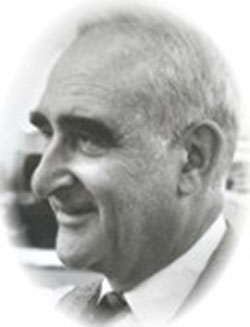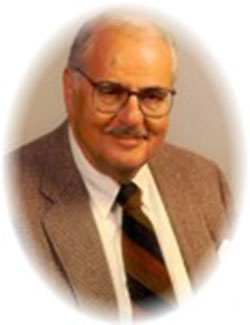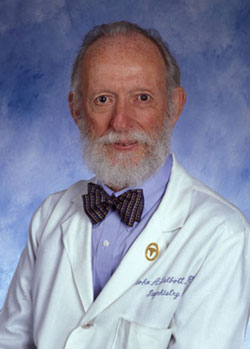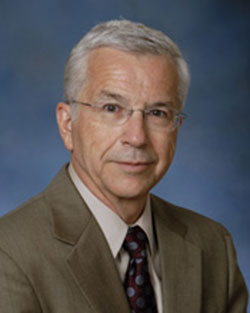A History of Innovation and Collaboration
A fuller version of this history of the Department of Psychiatry is available in the book, Changing Times, Changing Minds: 100 Years of Psychiatry at the University of Maryland School of Medicine. (Order your copy)

Jacob Finesinger, MD
In 1950, Jacob Finesinger, MD was recruited from Harvard to be the first full-time chair of the department of psychiatry at the University of Maryland School of Medicine. He was also the first director of the Psychiatric Institute, which opened in 1953 to provide patient care, psychiatric training, and research into the causes and prevention of mental illness. The state legislature had authorized funds to build the Psychiatric Institute after an exposé in1949 in the Baltimore Sun (a series called “Maryland’s Shame”) described understaffing and deplorable conditions in the state mental hospitals. There was great hope for psychiatry after World War II, during which the federal government had learned first-hand the relative effectiveness of a psychiatric intervention administered quickly and onsite for shell-shocked military personnel. Federal funds for psychiatric training had become plentiful and as new psychotropic drugs introduced in the 1950s began proving effective at relieving many symptoms of psychosis, more federal funds for biomedical research became available, too.
Finesinger emphasized medical student education, his forte at Harvard, providing legendary training sessions on how to interview patients. He also recruited full-time faculty and planned and oversaw building of the Psychiatric Institute, which opened in 1953 on a site on Redwood Street now occupied largely by the Shock Trauma Center. Since then, the department has grown greatly, its history in many ways mirroring that of American psychiatry.
 Eugene B. Brody, MD
Eugene B. Brody, MD
When Dr. Finesinger died in 1959, Eugene B. Brody, MD, whom he had recruited, was appointed department chair. Personally interested in cross-cultural aspects of psychiatry, Dr. Brody recruited a diverse faculty with interests in a variety of disciplines. In 1961, Child Psychiatry became an official division, with Dr. Frank Rafferty as director. In 1966, as part of a national shift toward community psychiatry, Dr. Lindbergh Sata began supervising planning for the Walter P. Carter Center, which would open in the mid-1970s.
In 1970, the department established the Combined Accelerated Program in Psychiatry (CAPP), a unique psychiatry track for medical students, which extended through all four years of medical school. The brain-child of Dr. Walter Weintraub, and co-directed initially with Dr. George Balis, the program is still an important tool for introducing psychiatry and mental health concepts to medical students, influencing decisions of some to specialize in psychiatry.
At roughly the same time that CAPP started, the Psychiatric Institute underwent a name change, becoming the Institute of Psychiatry and Human Behavior (IPHB), reflecting an effort to be interdisciplinary, addressing issues of mental health and mental illness as aspects of behavior in all its sociocultural and neurobiological dimensions. The new name suggested both a clinical identity and a research and scientific identity—moving along a track encouraged by the National Institute of Mental Health (NIMH).
 Russell R. Monroe, MD
Russell R. Monroe, MD
In 1976, Dr. Brody resigned as Chair and Russell R. Monroe, MD, was appointed as the third chair. Under his leadership, several remarkable things happened in the department. Most important, after a series of negotiations encouraged by Walter Weintraub, the state of Maryland changed the way it recruited and trained its mental health manpower and the way it provided mental health services. The department and the state’s Mental Hygiene Administration (MHA) agreed to a collaborative arrangement — the multi-award-winning “Maryland Plan” — through which the department would provide residency training in three state mental hospitals (Springfield, Spring Grove, and Crownsville) and the Walter P. Carter Center, a state-funded community mental health center near the university hospital. By integrating university and state residency training programs, creating a more academic environment in state treatment facilities, and rapidly promoting talented young psychiatrists to positions of authority, the Maryland Plan, implemented in 1978, significantly increased the percentage of graduates entering state psychiatry in the 15 years after the plan was implemented.
The department also agreed to run the Carter Center, which had been established in 1966 under the Federal Community Mental Health Act. The relationship between the department and the Carter Center, which had waned as federal funds were phased out in 1972, was rejuvenated by the 1978 agreement.
As a result of the same negotiations, management of the Maryland Psychiatric Research Center (MPRC) was transferred from the state to the department. William Carpenter Jr., MD, a nationally prominent schizophrenia researcher, was recruited to direct the MPRC. Under his leadership, it became a leading center for schizophrenia research, with significant contributions by such researchers as Robert Schwarcz, Carol Tamminga, Gunvant Thaker, and Robert Buchanan. Carpenter became principal investigator for five NIMH centers.
In 1984-85, the University of Maryland, which had been a state hospital (with a substantially shrinking state subsidy), became a private not-for-profit hospital complex, the University of Maryland Medical System (UMMS). In 1974, the department had established a faculty practice plan, Psychiatry Associates, under university guidelines. In the 1980s, federal subsidies for medical education had shrunk and private insurers as well as Medicare, Medicaid, and other government programs were no longer willing to finance lengthy stays and staff-intensive therapy. Managed care and a growing emphasis on biological (particularly pharmaceutical) and short-term approaches to managing mental illness were changing the emphasis in psychiatric training and practices. Still, the department maintained a tradition of psychodynamic psychotherapy and other therapies to balance biochemical approaches to treatment.

John A. Talbott, MD
In 1985, Dr. Monroe resigned and John A. Talbott, MD, president of the American Psychiatric Association, was appointed department chair. As APA president, he articulated the need for more research, more care, and more creative approaches for the state’s most vulnerable, stigmatized and problematic patients. Under him, a department that had been psychoanalytically driven began to focus on developing a model public psychiatry system to serve the underserved population of patients with schizophrenia and other serious and persistent mental illnesses.
In 1987 the MPRC launched the Maryland Brain Collection—human brain tissue collected post-mortem from organ donors, for use studying the biological and genetic basis of mental illness. The MPRC became the founding institution for the International Congress on Schizophrenia Research. And in 1999 the Swiss firm Novartis Pharma AG awarded the MPRC a grant of $24 million over six years to discover new treatments for schizophrenia (the largest such grant in the medical school’s history).
The department established a strong downtown research presence to complement the strong MPRC program in neuroscience and schizophrenia. Toward that end, in 1990 the new Center for Mental Health Services Research was established, under the leadership of Howard Goldman and Tony Lehman. The Program for Assertive Community Treatment (PACT) was introduced in a grant-funded demonstration project, as part of the Division of Community Psychiatry. PACT was accepted by the state as a reimbursable service in the mid-1990s and in 2006 was accepted as an evidenced-based mental health service, provided to both adults and children who were homeless and mentally ill. Alcohol and Drug Abuse Services returned to the department after 15 years under the direct aegis of the Dean's Office.
In 1989, psychiatric rehabilitation was introduced as part of community psychiatry and the department developed strength in rehabilitation and other psychosocial and vocational therapies. In the division of child and adolescent psychiatry, the Center for School Mental Health, led by Mark Weist, PhD, began developing strength. It was awarded a federal grant from the Health Resources and Services Administration (HRSA) to establish one of two national Centers for School Mental Health Assistance.
Also in 1989, the R Adams Cowley Shock Trauma Center was completed, replacing part of the original L-shaped Psychiatric Center built more than 35 years earlier. Child Psychiatry moved to 701 Pratt Street in 1992. The rest of the department had joined them by 1997.
In 1991, geriatric psychiatry became the first of several official new psychiatric specialties to be added to the curriculum. (Today the department offers postgraduate fellowships in child and adolescent psychiatry, geriatric psychiatry, substance abuse, forensics, and consultation-liaison psychiatry.) In 1993 a psychiatric service was initiated in the new Baltimore Veterans Health Administration facility, which had opened across from University Hospital that year. The VA psychiatry service in Baltimore had started as a substance abuse program at the Baltimore Veterans Hospital at Loch Raven in 1971. (Previously the VA’s psychiatric residency training in Maryland had taken place at its Perry Point hospital.) The VHA site near the university made collaboration and joint training much easier. With the main facility so much closer, the department began allowing regular rotations at the VHA hospitals as part of residency training, which benefited everyone. In 1997, the department and the private Sheppard Pratt Health System also merged their psychiatric residency programs, strengthening training at both institutions. The department currently has one of the largest psychiatric training programs in the country.
In the mid-1990s, targeted case management (CSP) was developed to address the needs of mentally ill people who were having difficulty accessing community resources. The Social Security Income Project (SSI) followed, as an avenue for patients with mental illness to get help accessing entitlement benefits through the Social Security Administration. In the Division of Community Psychiatry, a complex system of comprehensive mental health services evolved, the majority of them fee-for-service. Patients with Medicare, Medicaid, or no insurance were entitled to receive care in this publicly supported mental health system.
In a speech at the National Press Club in 1998, Dr. Anthony Lehman and his team announced results of the AHCPR's Patient Outcomes Research Team’s (PORT) study on schizophrenia. They found that less than half of schizophrenia patients nationally were receiving appropriate doses of antipsychotic medications. They also found gaps in the use and availability of psychosocial and vocational therapies and family interventions. The department further strengthened its efforts in these areas.
The university was an early participant in a national shift toward a recovery model for mental health. Both the university and the VA moved from what had previously been a hospital-based system emphasizing maintenance and containment of individuals with chronic mental illness to a patient-centered recovery model for mental health, with an emphasis on hope and recovery. With such an approach, the goal is to partner with consumers and help them identify goals, develop strategies, and move toward success in managing illness and recovering a life of meaning – with the aim of improving their quality of life and integration/reintegration into the community. In the VA this orientation toward recovery is mandated nationally through the Uniform Mental Health Services package.
The department has grown dramatically, sometimes increasing its grants and contracts 20 percent a year, while maintaining its commitment to care, training and research for those suffering the most from devastating mental illnesses. Allan Bellack, a joint UMB-VA appointment, successfully applied for one of eight VA Mental Illness Research Education and Clinical Centers (MIRECCs) in the nation, to improve the care of veterans with schizophrenia and other serious mental illnesses
 Anthony F. Lehman, MD, MSPH
Anthony F. Lehman, MD, MSPH
Anthony F. Lehman, MD, MSPH, was appointed chair in 2000. A world-renowned researcher in mental health services, Dr. Lehman has focused on assessing the outcomes of patients with severe mental illnesses and developing treatments and strategies for improving their well-being. Dr. Lehman had directed the department's Center for Mental Health Services Research for over a decade. His goals are to substantially expand the department’s research mission while maintaining and strengthening its outstanding training and clinical programs. He strongly promotes the long-standing partnership between the University of Maryland, the state hospitals, and Maryland’s public mental health system.
The department is partnering with the state to promote evidence-based practice, monitor performance, and raise standards of care throughout the state. In 2001, the Mental Health Services Improvement Collaborative (MHSIC) was established as part of the Division of Services Research, directed by Lisa Dixon, MD, and overseen by Howard Goldman, MD, PhD. This academic-public partnership with the Mental Hygiene Administration—an extension of the Maryland Plan — comprises three centers: the Mental Health Services Training Center, in operation since 1991, the Evidence-Based Practice Center (EBPC), and the Systems Evaluation Center (SEC), established in 2001. The child and adolescent division initiated an Innovations Institute in 2005, to develop a model of care called wraparound services, for families of children with intensive needs.
The department’s partnership with the Veterans Health Administration is stronger than ever, providing many joint training and research opportunities. The VA in the mid-1990s reorganized into a system of networks, making the system more integrated in operations and clinical research between sites (such as Baltimore and Perry Point). To everyone’s benefit, VA pioneered in innovations such as electronic medical records (to facilitate treating VA patients wherever they are) and telepsychiatry (treatment at a distance, which is important for patients in rural and other understaffed areas), an effort led by Brian Grady, MD, a joint recruit of VA and the department).
In 2004 MPRC and Oxford University Press jointly assumed ownership and responsibility for publishing Schizophrenia Bulletin — the only jointly owned Oxford journal. In 2005 MPRC started a $25 million contractual collaboration with NIDA to study co-occurring disorders. In 2010 MPRC set up a major neuroimaging center, with funding from NIMH. The same year, the department celebrated its sixtieth anniversary as an official department of the medical school with publication of the department’s history, Changing Times, Changing Minds: 100 years of Psychiatry at the University of Maryland School of Medicine by Pat McNees (Order your copy).
Dr. Lehman’s priorities for research development include research on mood and anxiety disorders, child and adolescent disorders, and geriatric disorders. He also seeks to more fully integrate the department’s major centers of research excellence on schizophrenia and other severe mental illness, including the Maryland Psychiatric Research Center, the VA Mental Illness Research Education and Clinical Center (MIRECC), and the Center for Mental Health Services Research.
The department aims to strengthen clinical and basic research by contributing new knowledge that will improve care for people with mental disorders. This effort will benefit both patients and the medical students and residents being trained to care for them. The department remains committed to its CAPP program and to pre-doctoral education generally (ensuring that all medical students at the university are trained to recognize, diagnose, and be familiar with treatment options for mental disorders); to post-doctoral education for future psychiatrists; and to the care of Maryland’s patients.
